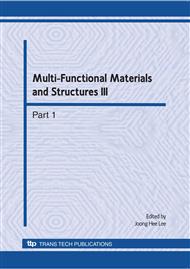p.987
p.991
p.995
p.999
p.1003
p.1007
p.1011
p.1015
p.1019
On the Generated Heat at Advancing/Receding of Water on Surface Engineered Nanoporous Silica
Abstract:
In this work, ratio of the generated heat relative to the dissipated energy, during the cyclical advancing/receding of water on surface engineered nanoporous silica is evaluated based on a thermographical method. Proposed test rig is a compression-decompression cylinder divided into two chambers, one of constant volume and the other of variable volume. Silica particles are introduced inside the cavity of fixed volume, and a micro-filter is used to separate it by the chamber of variable volume, in which only water is supplied. Using an infrared-camera, the temperature distribution on the external surface of the cylinder is recorded versus the working time, and positions of the main heat sources are identified. Such tests allow evaluation of the dissipated energy and generated heat. One finds that the surface engineered nanoporous silica is able to dissipate large amounts of mechanical energy without significant heating, i.e., maximum 17 % of the dissipated energy is emitted in the infrared frequency range. Such result is surprising since the emissions recorded from traditional frictional dissipaters, such as hydro-pneumatic absorbers, rubber and foam absorbers, etc., are mainly (about 90%) in the infrared range, and only partially in the audio and visible frequency range.
Info:
Periodical:
Pages:
1003-1006
Citation:
Online since:
August 2010
Authors:
Price:
Сopyright:
© 2010 Trans Tech Publications Ltd. All Rights Reserved
Share:
Citation:


